Matt
Bumblebee Goby Care, Tank Mates, Diet, Breeding, & More
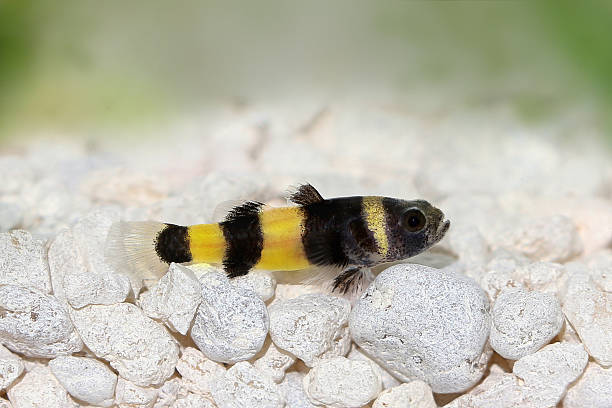
Discover the world of Bumblebee Gobies, small, brightly striped fish that bring a unique charm to brackish aquariums. This guide offers practical tips for their care, making it easier for both new and experienced fishkeepers to provide the best environment for these delightful creatures.
Bumblebee Goby Facts & Overview:
- Care Level: Moderate – Ideal for enthusiasts ready to step up from freshwater tanks.
- Color & Size: Vibrant yellow and black stripes; grow up to 1.5 inches.
- Tank Setup: Brackish water; a mix of salt and freshwater.
- Ideal Tank Mates: Best with other Bumblebee Gobies or small, peaceful brackish water fish.
Common Behavior:
- Nature: Shy and peaceful; can be territorial during breeding.
- Group Dynamics: Prefer living in groups but need space for individual territories.
Bumblebee Goby Appearance:
- Distinctive Features: Bumblebee-like stripes; males are more colorful, especially during breeding seasons.
Tank and Habitat Conditions:
- Substrate: Soft, sandy bottom to mimic their natural habitat.
- Water Parameters: Temperature 72-84°F, pH 7.0-8.5, specific gravity 1.005-1.008.
- Decorations: Rocks, driftwood, and plants like Java Fern or Anubias Nana that tolerate brackish water.
Aquarium Size Requirements:
- Minimum Size: 10 gallons for a small group.
- Space Per Fish: At least 3-5 gallons per Goby to prevent stress and territorial disputes.
Choosing Tank Mates:
- Compatible Species: Small, peaceful fish like Guppies and Mollies that can adapt to brackish conditions.
- Avoid: Large or aggressive fish that might stress or prey on the Gobies.
Social Dynamics of Bumblebee Gobies:
- Ideal Ratio: A balanced male-to-female ratio to minimize aggression.
- Group Benefits: Social interaction is beneficial; single Gobies may become stressed.
Dietary Needs:
- Preferred Diet: Live or frozen brine shrimp, daphnia, and bloodworms.
- Feeding Tips: Small, frequent meals; avoid overfeeding to maintain water quality.
General Care Guidelines:
- Regular Maintenance: Weekly water testing and changes are crucial.
- Monitoring: Watch for signs of stress or illness, like changes in color or appetite.
Breeding Bumblebee Gobies:
- Setting Up: Separate breeding tank with similar conditions.
- Care for Fry: Initially feed with infusoria or finely crushed flake food, transitioning to baby brine shrimp as they grow.
Suitability for Your Aquarium:
- Considerations: Ideal for aquarists interested in brackish environments and willing to maintain specific water conditions.
- Reward: Their unique behavior and striking appearance make the effort worthwhile.
FAQs:
- Freshwater Tolerance: Can adapt to freshwater but thrive in brackish conditions.
- Compatibility with Other Species: Limited due to their specific habitat needs.
Conclusion: Embrace the challenge of keeping Bumblebee Gobies and enjoy the rewards of their vibrant presence in your aquarium. Share your experiences or questions below to connect with fellow enthusiasts.
Celestial Pearl Danio Care, Size, Tank Mates, and More
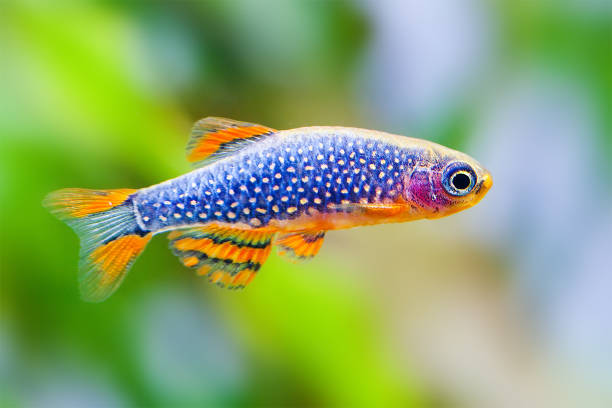
In the world of aquarium enthusiasts, the Celestial Pearl Danio stands out as a stellar choice. Known for its striking blue body and reddish fins adorned with pearly dots, this fish, often referred to as the Galaxy Rasbora, brings a touch of celestial beauty to any tank. Popular among hobbyists, it combines stunning appearance with a calm demeanor, making it a perfect addition to many community aquariums.
Facts & Overview of Celestial Pearl Danio
- Care Level: Easy, making it suitable for beginners.
- Temperament: Peaceful, preferring to live in small groups.
- Appearance: Blue body with distinctive reddish fins and pearly dots.
- Lifespan: Can live for 3-5 years with proper care.
- Size: Grows to about 0.75 to 1 inch in length.
- Diet: Omnivorous; a mix of flakes, pellets, and live food is ideal.
- Family: Belongs to the Cyprinidae family.
- Minimum Tank Size: 10 gallons for a small group of 5-6 fish.
- Tank Setup: Thrives in well-planted tanks that mimic their natural habitat.
- Compatibility: Best with small, peaceful fish species.
Appearance and Gender Differences
Male Celestial Pearl Danios boast brighter colors and thinner bodies, with deep blue shades and vivid pearl-like spots. Females, on the other hand, are less bright and have fewer pearly dots. They can be identified by their orange or translucent fins.
Tank Requirements and Habitat
These Danios originate from small streams and ponds filled with dense vegetation. They prefer temperatures between 65°F – 80°F and a pH range of 6.5 – 7.5. The tank should replicate these conditions, emphasizing a well-planted environment with a soft to medium water hardness.
Aquarium Size Requirements
A 10-gallon tank is the minimum recommendation for a group of 5-6 fish, with an additional 2 gallons per extra fish to ensure adequate space.
Tank Mates
Celestial Pearl Danios are compatible with other small and peaceful species like Ember Tetras, Glowlight Danios, Harlequin Rasboras, and Amano Shrimp. It’s crucial to avoid larger or aggressive fish that may stress or harm them.
Diet and Feeding
They consume a variety of plants, algae, zooplankton, and small invertebrates. In captivity, they need a balanced diet of high-quality flakes or pellets, along with live or frozen foods like brine shrimp and daphnia, is optimal. Feeding should occur 2-3 times per day in small amounts.
Care
Regular maintenance, including weekly 25-30% water changes, is vital. Ensuring clean and stable water conditions helps minimize stress and prevent illness.
Breeding
Celestial Pearl Danios are somewhat easy to breed in captivity. A breeding tank should include elements like Java moss and aged water. After spawning, it’s important to remove the adults to protect the eggs. Fry should be fed micro foods initially, transitioning to brine shrimp as they grow.
Is the Celestial Pearl Danio Right for Your Aquarium?
These Danios are an excellent choice for small, well-planted community tanks. They’re ideal for both novice and experienced aquarists looking to add a splash of color and activity to their aquatic setup.
Conclusion
The Celestial Pearl Danio is not just a fish; it’s a living piece of art that brings the wonders of the aquatic galaxy into your home. Its low maintenance requirements, peaceful nature, and stunning appearance make it an ideal choice for many aquarium enthusiasts. If your tank meets their needs, these celestial swimmers will surely bring joy and tranquility to your underwater world.
Top 10 Best Aquarium Vacuum Cleaners
Keeping an aquarium clean is vital for the health and well-being of its inhabitants. Aquarium vacuum cleaners are indispensable tools in this regard, offering an efficient way to remove debris and maintain the substrate. In this guide, we’ll explore the essential factors to consider when purchasing an aquarium vacuum cleaner and delve into some frequently asked questions to help you make the best choice for your aquatic environment.
Best Aquarium Vacuum Cleaners
| Rank | Aquarium Vacuum Cleaner | Description | Check Price |
|---|---|---|---|
| 1 | Laifoo Aquarium Siphon Vacuum Cleaner | Known for its ease of use and effective siphon system, suitable for regular maintenance in a variety of tank sizes. One of the best aquarium siphons on the market. | Check Price |
| 2 | KASAN Aquarium Gravel Cleaner | Versatile cleaner, ideal for both freshwater and saltwater aquariums, with a user-friendly design. | Check Price |
| 3 |
Luigi’s Fish Tank Cleaner |
An hand powered gravel pump that offers convenience with its powerful cleaning capacity, especially suited for medium to large tanks. | Check Price |
| 4 | Hygger Automatic Fish Tank Vacuum Cleaner | A precision tool perfect for densely planted tanks or delicate substrates, offering gentle yet effective cleaning. | Check Price |
| 5 |
AKKEE Electric Aquarium Gravel Cleaner |
6-in-1 electric cleaner. Balances performance with affordability, making it a great option for medium-sized aquariums requiring regular cleaning. | Check Price |
| 6 | Enomol Gravel Aquarium Vacuum Cleaning | This model is designed for ease of assembly and effective debris removal, making it a practical choice for everyday tank maintenance. | Check Price |
| 7 | AQQA Aquarium Gravel Cleaner | Features a user-friendly design with efficient cleaning capabilities, suitable for aquarists of all experience levels. | Check Price |
| 8 |
AREPK Aquarium Siphon Vacuum |
Simple and effective, this cleaner is ideal for smaller tanks, offering straightforward operation for routine maintenance tasks. | Check Price |
| 9 | Fluval ProVac | A powered cleaner with spotlight LED, suitable for a range of cleaning tasks in various aquarium setups. | Check Price |
| 10 | Bedee Aquarium Automatic Cleaner Vacuum | An automatic cleaner that reduces manual effort, designed for convenience and ease of use, particularly in larger tank setups. | Check Price |
Choosing the right aquarium vacuum cleaner depends on various factors. Here’s what you should consider:
- Tank Size: The size of your aquarium dictates the type of cleaner needed. Larger tanks require stronger suction power.
- Substrate Type: Different substrates might need different types of cleaners. For example, finer substrates like sand require a cleaner with adjustable flow to avoid disturbing it.
- Ease of Use: Consider a cleaner that is easy to assemble and operate. This makes the cleaning process more efficient and less time-consuming.
- Features: Look for features like adjustable flow rates, length of siphon tube, and type of suction mechanism. These can greatly affect the cleaner’s performance.
- Price: Balance between affordability and quality. It’s important to invest in a cleaner that will be durable and effective.
Frequently Asked Questions:
- How do I clean sand in my aquarium with a vacuum cleaner?
- When cleaning sand, you need a vacuum cleaner with adjustable flow rate to gently remove debris without sucking up the sand. Move the vacuum cleaner just above the surface of the sand, allowing the suction to lift the debris without disturbing the underlying sand.
- How often should I clean the gravel in my aquarium?
- The frequency of cleaning depends on factors like the size of your tank, the number of fish, and the type of food you feed them. Generally, cleaning the gravel every two weeks is recommended. However, if you have a heavily stocked tank or feed your fish heavily, you might need to clean it more frequently.
- Can I use the same vacuum for different types of aquariums?
- Yes, many aquarium vacuums are versatile and can be used in different types of aquariums. However, you should ensure that the vacuum is suitable for the specific size and substrate of each aquarium. For instance, a vacuum designed for a large tank with coarse gravel may not be appropriate for a small tank with fine sand.
- What are the differences between electric and manual aquarium vacuums?
- Electric vacuums are more powerful and require less physical effort, making them ideal for larger tanks or more thorough cleanings. Manual vacuums, on the other hand, offer more control and are often more affordable. They are suitable for smaller tanks or for aquarists who prefer a more hands-on approach.
- How do I prevent disturbing my fish while vacuuming the aquarium?
- To minimize stress on your fish, avoid rapid movements and keep the vacuum away from fish while cleaning. It’s also helpful to maintain a routine, so your fish get accustomed to the cleaning process. If possible, clean a portion of the tank at a time rather than the entire substrate at once.
Conclusion:
Selecting the right aquarium vacuum cleaner is essential for effective tank maintenance and the health of your aquatic life. By considering factors such as tank size, ease of use, and the type of substrate, you can find a cleaner that suits your specific needs. Remember, a clean aquarium is a happy and healthy home for your aquatic pets. Use this guide to navigate your options and make an informed decision for your aquarium cleaning needs.
Best Decorations for Betta Fish
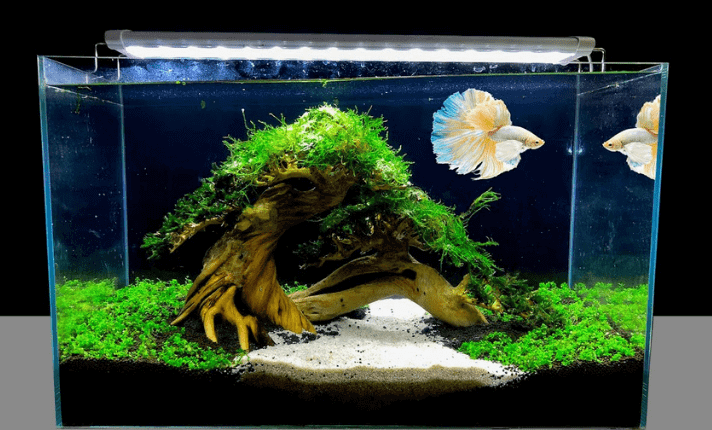
The best decorations for betta fish tanks are not just for aesthetics; they play a vital role in creating a habitat that resembles a betta’s natural environment. Decorations provide hiding spots and simulate the complex ecosystems where bettas naturally thrive, reducing stress and encouraging natural behaviors.
Top Betta Fish Tank Decorations
Artificial Plants
Artificial plants like Otterly Pets Aquarium Plants offer a vibrant, maintenance-free option for your tank. Made from soft plastic without metal wiring, these plants are safe for bettas, preventing fin damage and adding color to your aquarium.
Stone Hideaways
The Penn Plax Stone Hideaway Decoration offers a realistic and safe hideout. Its textured surface allows beneficial bacteria to colonize, aiding in tank health, while the smooth edges ensure betta safety.
Betta Hammocks
Betta hammocks, such as the Zoo Med Betta Bed Leaf Hammock, replicate the natural resting spots found near the water surface in a betta’s habitat. These hammocks provide a secure place for bettas to rest, enhancing their comfort and reducing stress.
Floating Betta Log
Zoo Med’s Floating Betta Log offers a natural hideout at the surface, where bettas love to spend time. Made from real wood and free from chemicals, this log is a safe and intriguing addition to any betta tank.
Themed Decorations
For a whimsical touch, themed decorations like the Penn Plax Spongebob Squidward Easter Island Ornament add a fun element to the tank while providing a hideaway for your betta.
Driftwood
Pieces of driftwood, such as the Fluval Mopani Driftwood, add a natural aesthetic to the tank. They serve as focal points and hiding spaces, enhancing the tank’s environment.
Ping Pong Balls
Simple yet engaging, ping pong balls like Champion Sports Ping Pong Balls can keep your betta entertained, encouraging play and activity at the water’s surface.
Ceramic Decorations
Ceramic decorations, such as Norgail Ceramic Jar Decoration, offer a safe and stylish option for bettas to explore and hide. They add an ancient and mysterious flair to the tank.
Betta Exercise Mirrors
Betta Exercise Mirrors provide a unique form of stimulation for bettas, encouraging them to display and exercise. However, their use should be limited to prevent stress.
Aquarium Air Stone Kits
Aquarium air stone kits, like the Hygger Aquarium Air Stone Kit, not only decorate the tank but also help oxygenate the water, creating a dynamic and healthy environment for your betta.
Tips for Choosing and Arranging Decorations
When selecting decorations, ensure they are made from safe materials and have no sharp edges. Arrange your tank with a mix of hiding spots, open swimming areas, and interactive elements to provide a balanced and stimulating environment for your betta.
Final Thoughts
The right decorations can transform your betta’s tank into a stimulating and comforting home. By choosing items that cater to their natural behaviors and preferences, you create an environment where your betta can thrive. In 2023, the options are more diverse and engaging than ever, offering endless possibilities to enhance the life of your aquatic companion.
Betta Fish Water Temp Guide
It is important to maintain a specific temperature range for Betta fish to ensure their good health and well-being. Betta splendens, the most common species of betta fish, thrives in water that has a temperature between 75°F-80°F (24°C and 27°C). Although bettas can survive in water with a temperature range 72°F-86°F (22.22°C and 30°C), it is highly recommended to maintain the water temperature within the 78°F to 80°F range for optimal health and vitality. Remember, it’s essential to keep the water temperature within the recommended range to ensure your Betta fish is healthy and happy!
Factors Affecting Water Temperature
- Room Temperature: The temperature of the room where the aquarium is located plays a significant role in determining the water temperature.
- Aquarium Heater: An essential tool for maintaining consistent water temperature.
- Aquarium Size: Smaller aquariums are more prone to rapid temperature fluctuations compared to larger tanks.
- Heating Equipment Placement: Proper placement of the heater ensures even distribution of heat in the tank.
- Seasonal Changes: Seasonal variations can affect room temperature, which in turn can impact water temperature in the aquarium.
Risks of Incorrect Water Temperature
- Too Hot: Overheating can cause rapid breathing, erratic swimming, stress, and a weakened immune system. Betta fish in overly warm water may exhibit overactive behavior and may struggle with oxygen absorption due to lower dissolved oxygen levels in warmer water.
- Too Cold: Lower temperatures can slow down a betta’s metabolism, leading to inactivity, loss of appetite, and increased susceptibility to diseases. It’s crucial to avoid sudden temperature drops as bettas are sensitive to rapid changes.
How to Maintain Ideal Water Temperature
- Use a Reliable Aquarium Heater: Invest in a quality heater suitable for the size of your tank. Regularly check the heater to make sure it’s functioning correctly.
- Monitor Water Temperature Regularly: Employ a reliable aquarium thermometer and check the temperature frequently to ensure it stays within the ideal range.
- Gradual Adjustments: When changing water or adjusting temperatures, do so gradually to avoid shocking the fish.
- Consider Aquarium Location: Place the aquarium in a stable environment, away from direct sunlight, heaters, or air conditioning units.
Conclusion
Maintaining the ideal water temperature is a crucial aspect of betta fish care. By understanding the specific needs of betta fish and the factors affecting water temperature, you can create a stable and healthy environment for these beautiful creatures. Regular monitoring and proper equipment are key to ensuring the well-being of your betta fish.
Do Goldfish Need Air Pump Or Bubbler? (Complete Guide)
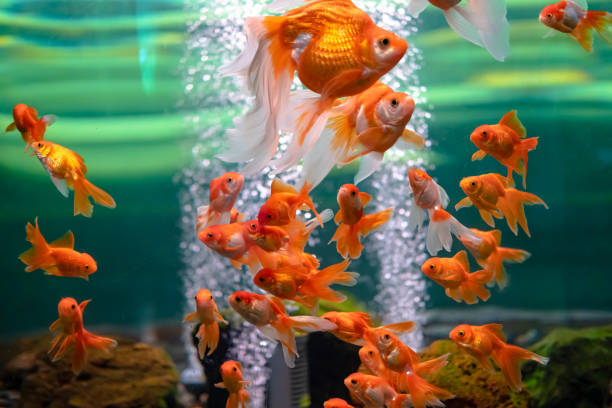
Goldfish are a popular choice for both beginner and experienced aquarists, but their care often raises questions, especially regarding their oxygen needs. This comprehensive guide explores whether goldfish need an air pump or bubbler in their tank, ensuring your finned friends thrive in their aquatic environment.
Suggested Air Pumps for Goldfish Tank
When it comes to selecting an air pump for your goldfish tank, there are several top-notch options. Key features to consider include the pump’s power, noise level, and durability. Recommended models like the AquaClear Powerhead and Tetra Whisper Air Pump offer efficient oxygenation with minimal noise, making them ideal for home aquariums.
Your Goldfish Needs More Oxygen?
Goldfish show clear signs when oxygen levels in their tank are low. Watch for symptoms like lethargy, gasping at the water’s surface, or reduced appetite. These behaviors indicate that it’s time to improve aeration in the tank.
Can Goldfish Live Without an Air Pump?
While goldfish can survive in a bowl, it’s far from the ideal environment. Bowls limit oxygen supply and don’t provide enough space for goldfish to grow. If a bowl is your only option, ensure regular water changes and consider using aquatic plants to increase oxygen levels.
Why is My Goldfish Gulping Air at the Surface?
If your goldfish is frequently gulping air at the water’s surface, it’s a distress signal. This behavior usually means the oxygen in the water is insufficient. Immediate steps should be taken to enhance aeration in the tank.
How to Add Oxygen to the Fishbowl
Besides air pumps, there are several ways to increase oxygen in a fishbowl. Adding live aquatic plants can help, as they release oxygen during photosynthesis. Regular water changes and a good filter system also contribute to a well-oxygenated environment.
How Long Can Goldfish Live Without an Air Pump?
The lifespan of goldfish without an air pump varies, but oxygen is vital for their health and longevity. While some goldfish might survive for short periods in low-oxygen environments, their health will likely suffer.
The Size of a Goldfish
The size of a goldfish is a good indicator of its health and the care it receives. In a well-maintained tank with adequate space and oxygen, goldfish can grow significantly, leading to a healthier and longer life.
Conclusion
Providing adequate oxygen through an air pump or bubbler is crucial for the health and wellbeing of your goldfish. While alternative methods can help, especially in smaller setups like bowls, investing in a good air pump is often the best way to ensure your goldfish thrive. Remember, healthy goldfish are active and lively, and the right tank environment plays a key role in achieving this.
Red Tail Shark Care, Food, Tank Mates, & More
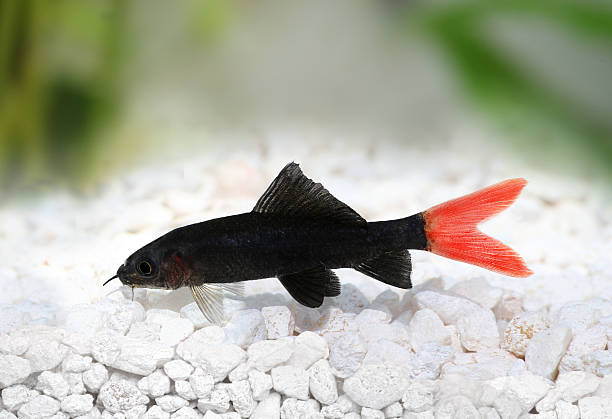
In the diverse world of freshwater aquariums, the Red Tail Shark (Epalzeorhynchos bicolor) stands out as a striking and popular choice among hobbyists. Despite their semi-aggressive nature, these fish captivate with their vivid colors and dynamic behavior. This guide delves into the essential care requirements, helping you ensure a thriving environment for these unique fish.
Understanding Red Tail Sharks
Origin and Appearance
Native to Thailand’s Chao Phraya basin, the Red Tail Shark is easily recognized by its deep black body contrasted with a bright red caudal fin. Averaging between 4 to 6 inches in length, they add a dash of color and movement to any aquarium.
Lifespan
With proper care, these fish can live between 5 to 8 years, making them a long-term commitment for aquarium enthusiasts.
Creating the Ideal Habitat
Tank Requirements
- Size: 55 gallons is recommended to provide sufficient space and minimize aggression.
- Water Conditions:
- Temperature: 72°F to 79°F.
- pH: 6.5 to 7.5.
- Hardness: 10-15 KH.
Aquarium Setup
- Substrate: Use moderately-sized gravel or pebbles to prevent accidental ingestion and mimic their natural habitat.
- Landscape: Incorporate plants like hornwort or water wisteria, driftwood, and caves to offer hiding spots and territorial markers.
- Lighting: Keep lighting dim to reflect their nocturnal nature.
- Filtration: Opt for systems that create a strong current, as Red Tail Sharks thrive in fast-flowing water.
Maintenance
Regular cleaning and water parameter checks are essential to maintain a healthy environment and prevent diseases.
Behavior and Social Structure
Temperament
Red Tail Sharks are known for their semi-aggressive and territorial behavior, especially in cramped conditions.
Tank Mates
Choose similarly sized tank mates. Compatible species include Bala sharks, Barbs, Cichlids, Danios, Gouramis, and Tetras. Avoid slow-moving or timid fish.
Diet and Nutrition
Feeding Habits
Red Tail Sharks are omnivores, enjoying a varied diet of pellets, live or frozen foods, and vegetables. Algae wafers can supplement their diet.
Feeding Schedule
Feed them once every couple of days, preferably in the evening, with sinking pellets to match their bottom-dwelling nature.
Health and Disease Management
Common Diseases
Watch out for signs of Ich and fin rot, common ailments that can be prevented with proper care and water quality.
Prevention and Care
Regular water changes, a balanced diet, and stable water parameters are key to preventing diseases.
Breeding Insights
Breeding Red Tail Sharks in a home aquarium is challenging due to their aggressive nature. Most specimens in the trade are bred in commercial farms.
Special Considerations
Conservation Status
These fish are critically endangered in the wild, which underscores the importance of responsible aquarium practices.
Jumping Behavior
Secure your aquarium with a weighted lid as Red Tail Sharks can jump, especially when startled or stressed.
Stress Indicators
A duller tail fin color indicates stress or illness. Regular observation and care are crucial to maintaining their wellbeing.
Conclusion
The Red Tail Shark is a captivating choice for experienced aquarium hobbyists. Their striking appearance and active nature make them a standout addition to any freshwater aquarium. Remember, success with Red Tail Sharks lies in attention to detail, patience, and a commitment to their wellbeing.
Green Spotted Puffer Fish Care, Feeding, and Tank Setup
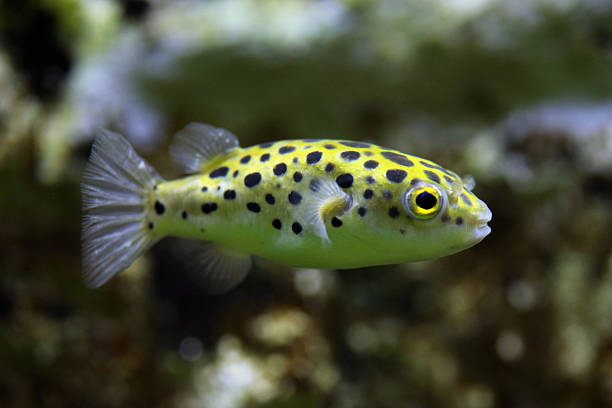
Green Spotted Puffer Fish, with their distinctive spots and unique personalities, make fascinating additions to any aquarium. However, they have specific needs that differ from typical freshwater fish. This article delves into the essentials of caring for these intriguing creatures, ensuring they thrive in your care.
Overview of Green Spotted Puffer Fish
These puffers boast a pale yellow body with greenish tints and black spots, resembling a leopard. Their small mouth, large eyes, and rounded body give them a distinctive appearance. Despite their small fins used for steering, they primarily rely on their tail for movement. Capable of growing over 6.5 inches, they are known for their intelligence and their ability to recognize their owners. Their aggressive and territorial nature suggests they are best kept alone in an aquarium.
Overview of Green-Spotted Puffer Fish
- Appearance: GSPs have a pale yellow, slightly green body with irregular black spots and a bright white belly. Their rounded body resembles a blimp, tapering at the small tail. They have small, translucent pectoral fins and use their tail for propulsion.
- Behavior and Temperament: They are extremely aggressive and territorial, best kept alone. Recognized for their intelligence, they can show emotions and even learn tricks. They are also known to be escape artists.
- Size: They can grow over 6.5 inches (16 cm).
Tank Setup
- Tank Size: Minimum of 55 gallons for one puffer, with an additional 20 gallons for each additional fish.
- Water Parameters:
- Temperature: 74-82°F (23-28°C).
- pH Levels: 7.0-8.5.
- Water Hardness: 8-12 dGH.
- Alkalinity Levels: 2-4 dKH.
- Specific Gravity: 1.005-1.015 for brackish water.
- Water Flow Rate: Moderate.
- Tank Landscape:
- Substrate: Soft, to prevent injuries from digging.
- Plants: Hardy plants like Java Ferns, Dwarf Sagittaria, and Anubias. Avoid plants that can’t survive in brackish waters.
- Decorations: Driftwood, rocks, caves, and twisted root plants.
- Lighting: Basic aquarium lighting, not too bright.
Feeding and Diet
- Diet: Consists mainly of invertebrates, mollusks, fish, and small worms. Include shellfish, bloodworms, brine shrimp, mysis shrimp, and occasionally algae and vegetable matter.
- Feeding: Live feeder shrimp and snails are essential, as their hard shells help maintain the puffer’s teeth length. Feed younger puffers daily and adults every other day, with portions they can consume within a few minutes.
Maintenance and Care Schedule
- Water Changes: 25% weekly, with regular monitoring of water quality.
- Equipment Inspection: Weekly check of filters, heaters, and other equipment.
- Tank Cleaning: Regular cleaning of substrate and decorations, ensuring ample hiding and swimming spaces.
Common Health Problems
- Diseases: Watch out for ich (white spots) and injuries from nipping.
- Preventive Measures: Regular tank maintenance and monitoring fish behavior.
Breeding
- Difficulty: Breeding GSPs in captivity is challenging and hasn’t been successfully achieved by hobbyists; all specimens are wild-caught.
Conclusion
Green Spotted Puffers are fascinating and unique but require dedicated care and a well-maintained environment. Their aggressive nature means they are best kept alone. Regular maintenance, proper diet, and stable water conditions are crucial for their health and wellbeing.
This guide should offer a detailed and structured approach to caring for Green Spotted Puffers, catering to both novice and experienced fish keepers.
How To Breed Cory Catfish?
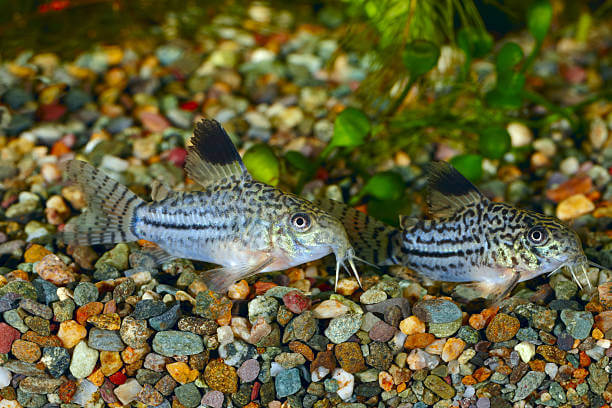
Corydoras catfish, affectionately known as “cory cats,” is a captivating addition to any freshwater aquarium. These peaceful bottom-dwellers are adorable and incredibly helpful, keeping your tank sparkling clean with their constant scavenging. But did you know you can witness the miracle of life firsthand by breeding these delightful fish? If you’re a novice considering buying or already have these charming creatures, this guide unveils the secrets of successful Corydoras breeding!
Corydoras Fun Facts:
- These tiny charmers come in a dazzling array of colors and patterns, with over 200 known species!
- Their lifespan can range from 5 to 10 years, offering years of companionship.
- They’re omnivores, enjoying sinking pellets, algae wafers, and even the occasional bloodworm treat.
- Corydoras are social creatures, thriving in groups of 6 or more. They even get along well with other peaceful fish!
Breeding Corydoras Catfish: A Responsible Guide to Witnessing the Miracle of Life
The playful antics and peaceful presence of Corydoras catfish, affectionately known as “cory cats,” have captivated aquarists worldwide. But have you ever considered witnessing the miracle of life firsthand by breeding these charming bottom-dwellers? While responsible breeding requires careful planning and knowledge, it can be a rewarding experience for any fish enthusiast.
Before We Begin: Responsible Breeding Matters
It’s crucial to emphasize responsible breeding practices before diving in. Overbreeding any fish can strain your resources and negatively impact animal welfare. Ensure you have a plan for the fry before embarking on this journey. Consider offering them to other responsible aquarists or local fish stores.
Know Your Corydoras:
Different Corydoras species have varying breeding requirements and temperaments. Start by researching the specific needs of your chosen species. Popular choices for beginners include Panda Corys, Bronze Corys, and Julii Corys.
Setting the Stage: Water Parameters and Tank Setup
Mimicking their natural environment is key to successful breeding. Research the ideal water temperature, pH, hardness, and conductivity for your specific Corydoras. Prepare a dedicated breeding tank with a gentle filter, a heater to maintain stable temperatures (usually around 75°F), and soft lighting. Choose a fine sand or gravel substrate for egg-laying and add some live plants for hiding places. Aim for slightly acidic water with a pH between 6.0 and 7.0.
Selecting Your Breeders:
Choose healthy, mature Corydoras (ideally a year old or older, over 2.5 inches long) with a mix of males and females. Males are generally slimmer with longer fins, while females are more rounded with shorter fins. Observing their behavior can also help differentiate them, as males tend to chase and nudge females during courtship.
Triggering the Magic: Simulating the Rains
Mimic their natural breeding season by slightly lowering the water temperature by a few degrees and performing frequent small water changes. This simulates the arrival of rain in their native habitat and can trigger breeding behavior. Offer a varied diet to keep them in top condition.
The Dance of Love: Witnessing the “T-Pose”
When conditions are right, a fascinating display unfolds. The male will chase the female, performing a unique “T-pose” beside her to fertilize the eggs she carries. She then carefully attaches these sticky treasures to plants or other surfaces. However, Corydoras tend to snack on their eggs, so removing the parents after spawning is crucial.
Tiny Miracles Emerge: Hatching and Beyond
After a few days, witness the magic as tiny fry emerges from the eggs! Carefully remove any uneaten eggs to prevent water quality issues. Now comes the delicate part: caring for the fry.
Nurturing Microscopic Lives: Feeding and Growth
These microscopic marvels need infusoria or finely ground flakes for their first few days. As they grow, they switch to microworms and brine shrimp nauplii. Keep the water clean with frequent small water changes and monitor their growth. Once they reach maturity (around 3-4 months old), gently transfer them to a larger tank.
Ethical Considerations: Culling and Beyond
While some breeders cull weak or deformed fry, this is a sensitive topic with ethical considerations. Research and decide what aligns with your values before proceeding. Remember, providing all your fish with a good quality of life is paramount.
Beyond Breeding: Sustainable Practices
Always encourage responsible sourcing of fish and avoid wild-caught specimens. Support reputable breeders who prioritize fish welfare and genetic diversity.
Embrace the Journey, Breed Responsibly
Breeding Corydoras can be a fascinating and rewarding experience. Remember, thorough research, careful planning, and responsible practices are essential for success. With dedication and knowledge, you can witness the miracle of life and contribute to the responsible enjoyment of this captivating hobby.
Jack Dempsey Fish Care Guide
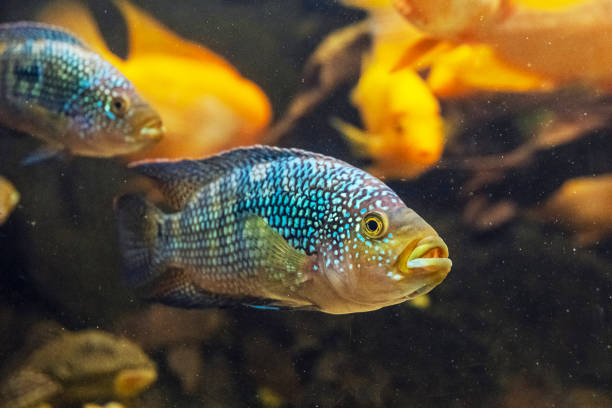
The vibrant colors, imposing size, and lively personalities of Jack Dempsey fish have captivated aquarists for years. But before you bring this Central American beauty home, understanding their needs is crucial. Whether you’re considering a future Dempsey companion or already have one swimming around, this detailed guide is for you!
Jack Dempsey Fish Care Guide
Imagine a dazzling blue-green body adorned with bold black stripes, a fiery red throat, and fins that flow like miniature flags. That’s the Jack Dempsey, named after the legendary boxer himself. These fish can reach a majestic 12 inches, living for 8-10 years with proper care. Bonus points for the diverse color variations like the Electric Blue Dempsey or the Red Head Dempsey – a feast for the eyes!
Building Your Dempsey’s Dream Home: Tank Talk
Now, let’s talk about creating the perfect underwater haven. While a single Dempsey thrives in a minimum 55-gallon tank, bigger is always better for their active swimming nature. Imagine an Olympic-sized pool for your fish friend! Remember, every additional Dempsey needs 30 gallons of space to avoid territorial squabbles.
Essential Equipment: Think of it as a fish spa! A powerful filter is key to keeping the water sparkling clean, as Dempseys are messy eaters. A reliable heater maintains its preferred tropical temperature (75-85°F). Don’t forget a thermometer to keep an eye on things and lighting to showcase their dazzling colors.
Plantscaping: Think sturdy! Opt for hardy plants like Anubias or Java Fern that can withstand their digging antics. Remember, they might rearrange your underwater garden – consider it their artistic touch!
Flooring it Right: Imagine a sandy beach – that’s what your Dempsey craves! A sandy substrate allows them to dig, explore, and feel right at home.
Decorations: Think “fish fortress”! Provide ample hiding places like rocks, caves, and driftwood. These territories help manage aggression and provide comfort zones. Think of it as their underwater sanctuaries.
Water Magic: Creating the Perfect Chemistry
Just like us, your Dempsey needs the right environment to thrive. Here’s the water recipe:
- Temperature: 75-85°F – think warm bath, not icy plunge!
- pH: 7.0-8.0 – slightly alkaline, like baking soda in water.
- Ammonia, Nitrite: 0 ppm – these are toxins, keep them out!
- Nitrate: Less than 20 ppm – a little is okay, but not too much.
- GH, KH: 8-20 dGH, 8-12 dKH – these minerals help keep things stable.
Jack Dempsey Fish Care Guide: A Handy Table
| Feature | Requirement | Notes |
|---|---|---|
| Tank Size | Minimum 55 gallons for 1 fish, 30 gallons more per additional fish | Larger is always better for their active swimming! |
| Filtration | Powerful filter | Crucial for clean water as they are messy eaters. |
| Heater | Maintains 75-85°F temperature | Tropical fish prefer warm water! |
| Plants | Hardy varieties like Anubias or Java Fern | They might rearrange your underwater garden! |
| Substrate | Sandy | Ideal for their digging behavior. |
| Decorations | Rocks, caves, driftwood | Provide ample hiding places and territories. |
| Water Temperature | 75-85°F | Think warm bath! |
| pH | 7.0-8.0 (slightly alkaline) | Like baking soda in water. |
| Ammonia, Nitrite | 0 ppm | Keep these toxins out! |
| Nitrate | Less than 20 ppm | A little is okay, but not too much. |
| GH, KH | 8-20 dGH, 8-12 dKH | Minerals for stability. |
| Tank Mates | Not recommended for community tanks | Aggressive, best kept alone or with compatible tank mates. |
| Suitable Tank Mates | Large Central American cichlids, Plecos, catfish (research compatibility!) | |
| Diet | Meat-based: pellets, flakes, bloodworms, brine shrimp, occasional live food | High-quality protein is key! |
| Feeding | Only what they finish in 2 minutes | Avoid overfeeding to prevent health problems. |
| Important Notes | Secure lid (jumpers!), careful water changes, monitor for diseases | Be a responsible fishkeeper! |
Sharing Your Tank (or Not): The Roommate Rundown
Jack Dempseys are known for their feisty personality. While they might seem tough, they prefer their company or carefully chosen tank mates.
Community Tank Caution: A community tank is a no-go unless you have a massive tank (think hundreds of gallons) and equally aggressive tank mates. Imagine a schoolyard bully – not a good fit for peaceful fish!
Suitable Roommates: If you insist on the company, consider other large Central American cichlids, Plecos, or catfish who can hold their own. Remember, research is key to ensure compatibility.
Mated Bliss (Maybe): Thinking of a couple? Provide a large tank with plenty of territories and monitor closely for aggression. Sometimes, even lovebirds need their space!
Feeding Frenzy: A Carnivore’s Delight
Think meat-lover’s paradise! These carnivores thrive on a diet of high-quality pellets, flakes, bloodworms, brine shrimp, and even occasional live food. Imagine a smorgasbord of protein-packed goodness!
Overfeeding Alert: Don’t go overboard! Feed them only what they can finish in 2 minutes and remove uneaten food promptly. Too much food can lead to health problems, like indigestion for your fish!
Is a Jack Dempsey Right for You?
These stunning fish can be rewarding companions, but they require commitment. They need a spacious tank, consistent water care, and a specific diet. If you’re an experienced aquarist who can provide these needs and appreciate their feisty personalities, then a Jack Dempsey might be your perfect match!